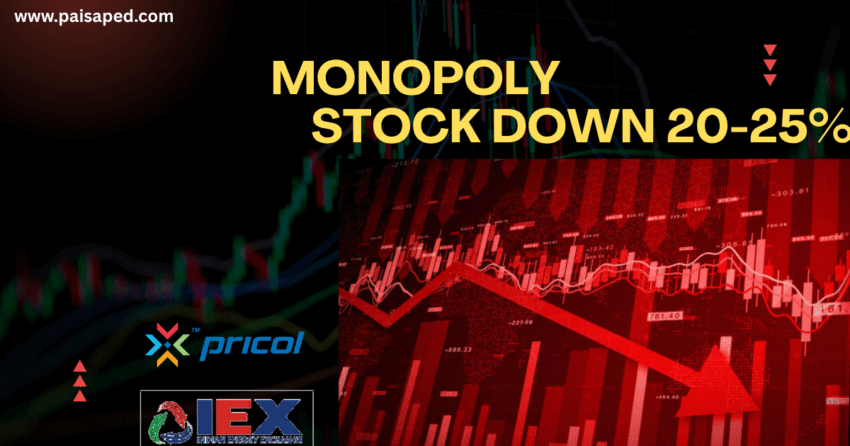2 Monopoly Stocks with 20-25% Correction – Investment Opportunity or Red Flag?
Meta Description:
Discover why Monopoly Stocks namely Pricol and Indian Energy Exchange (IEX), leaders in their sectors, have corrected 20–25%. Are they strong investment opportunities or value traps?
The Market Reality – Monopolies with Falling Stock Prices
The Indian stock market is full of competition-driven sectors, but in some areas, clear monopolies are emerging. Interestingly, two such market leaders – Pricol Limited (auto components) and Indian Energy Exchange (IEX) (power trading) – have witnessed 20–25% stock price correction in recent months.
This raises two key questions:
- Is this correction just a normal market reaction?
- Or is it indicating deeper structural or fundamental challenges?
Let’s analyze both of these monopoly stocks in detail to see if these are buying opportunities or warning signals.
Pricol Limited – The Auto Components Monopoly
Market Leadership
Pricol Limited is a leading auto component manufacturer, specializing in instrument clusters and connected vehicle solutions. The company enjoys a 55–60% domestic market share and up to 65% in the two-wheeler segment. Globally, Pricol is the second-largest instrument cluster manufacturer by volume.
Business Segments
- Driver Information & Connected Vehicle Solutions (60–65% revenue): Instrument clusters, telematics, and vehicle sensors.
- Actuation, Control & Fluid Management Systems (35% revenue): Fuel pump modules, disc brakes, and wiping systems.
Financial Performance FY25
- Revenue: ₹2,692 crore (+18.5% YoY)
- Operating Profit: ₹313 crore (+13.8% YoY)
- Operating Margin: 11.6% (-50 bps YoY)
- Net Profit: ₹167 crore (+18.4% YoY)
- PAT Margin: 6.2% (flat)
The revenue growth was fueled by premium product adoption (hybrid and electrochemical TFTs) and the acquisition of Sundaram Auto Components. However, expenses grew 19.8%, primarily due to 23% higher employee costs for R&D and engineering talent.
Balance Sheet & Cash Flow
- Trade receivables jumped 65% (₹287 cr → ₹473 cr), pushing receivable days from 46 to 64.
- Borrowings tripled to ₹183 crore, largely due to acquisitions and capex.
- Net cash flow turned negative (₹11 crore) because of ₹216 crore capex and ₹195 crore acquisition outflow.
Growth Outlook & Risks
- Target revenue: ₹3,600–4,000 crore by FY26 (13–15% CAGR).
- Margin guidance: 12–13% in core business.
- Risks:
- Supply chain constraints (rare earth magnets shortage could cut OEM production by up to 50%).
- Elevated employee costs from R&D hiring.
- Valuation: 33x PE, in line with five-year median, supported by 16% ROE CAGR.
Indian Energy Exchange (IEX) – The Power Trading Giant
Market Leadership
IEX operates India’s largest automated power trading platform, with a dominant 84% market share (FY25), making it a monopoly stocks. It enables trading in:
- Day Ahead Market (44% share) – Next-day delivery auctions.
- Real Time Market (28% share) – Electricity delivery within 1 hour.
- Green Market (6% share) – Renewable energy.
- Term Ahead Market (7% share) – Contracts up to 90 days.
- Certificates (RECs, eCerts) for compliance.
Financial Performance FY25
- Revenue: ₹537 crore (+19.6% YoY)
- Electricity Volumes: 12,100 crore units (+18.7% YoY)
- Operating Profit: ₹455 crore (+20% YoY)
- Operating Margin: 85% (expansion of 50 bps)
- Net Profit: ₹429 crore (+22% YoY)
Strong performance came from 136% growth in REC trading, 29% growth in Real Time Market, and 171% growth in Green Market.
Cash Flow & Balance Sheet
- Cash & Mutual Funds: ₹1,000 crore.
- Dividend payout: ₹267 crore.
- CFO/Net Profit ratio improved from 0.85x to 0.99x, indicating strong earnings quality.
Growth Drivers & Risks
- Rising power demand from GDP growth, EV adoption, data centers, and solar energy.
- IGX (Indian Gas Exchange) volumes surged 47% YoY.
- Regulatory support for carbon credit trading and long-term green energy contracts.
However, risks include:
- Market coupling regulation – could reduce IEX’s price discovery advantage.
- Growing competition from PXIL and HPX (market share down from 88% → 84.2%).
- Transaction fee decline (−8.6% in FY25).
Should You Buy These Monopoly Stocks After a 20–25% Correction?
Both Pricol and IEX are clear monopoly stocks in their sectors and have strong long-term growth drivers:
- Pricol benefits from premiumization and new OEM tie-ups (Honda, Suzuki) but faces near-term margin pressure and high receivables.
- IEX enjoys an asset-light model and high operating margins but is vulnerable to regulatory changes and competition.
Key Takeaways:
- Valuation matters – both of these monopoly stocks are trading near long-term average multiples.
- Corrections of 20–25% in strong market leaders can present long-term entry opportunities if fundamentals remain intact.
- Investors should monitor cash flow, receivable cycles, regulatory changes, and competitive landscape of these monopoly stocks before taking positions.
ALSO READ
Follow me on Twitter (X) or Facebook. Join WhatsApp Channel or Facebook Group for Updates.
Liked our article ? Subscribe to get weekly updates

